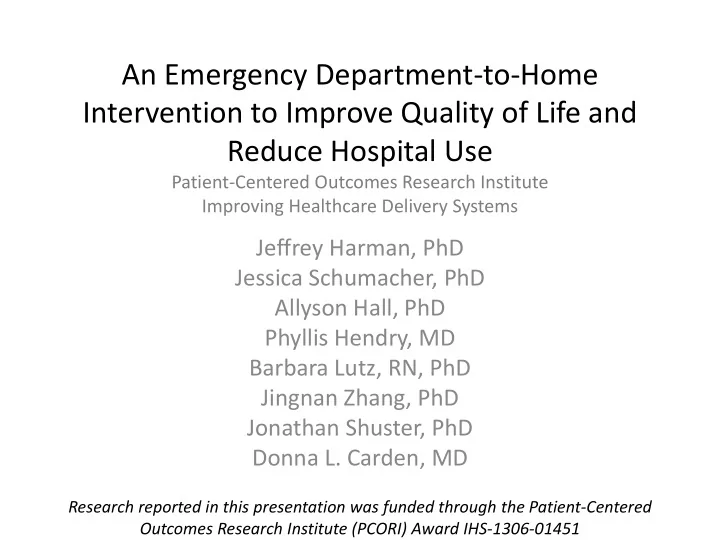

An Emergency Department-to-Home Intervention to Improve Quality of Life and Reduce Hospital Use Patient-Centered Outcomes Research Institute Improving Healthcare Delivery Systems Jeffrey Harman, PhD Jessica Schumacher, PhD Allyson Hall, PhD Phyllis Hendry, MD Barbara Lutz, RN, PhD Jingnan Zhang, PhD Jonathan Shuster, PhD Donna L. Carden, MD Research reported in this presentation was funded through the Patient-Centered Outcomes Research Institute (PCORI) Award IHS-1306-01451
Background • Improved care transitions, particularly for older, Healthcare chronically ill Americans is a national priority System • Many of the biggest drivers of health and health care costs Health- are beyond the scope of Patient Community related health care alone Social Needs • Rigorous research is needed to assess a causal link between care transition interventions Care and outcomes important to Coordination key ED stakeholders including ED patients
Background CTI= Care Transition Intervention % Hospital Readmissions Implemented by local Area Agency on 24.1% Aging 12.7% Before CTI After CTI Care Transition Interventions Implemented in Admitted Patients Reduce Hospital Readmissions
Background Most Medicare Beneficiaries Enter Through the ED Rand Corporation 2013: The Evolving Role of Emergency Departments in the United States.
PCORI Project Team 2013 Planning Meeting 2015 Team Meeting Compared to usual, post-ED care, can an intervention that links chronically ill, older patients with community-based medical and social support improve quality of life and reduce hospital-based healthcare use?
Methods Intervention Usual Care 504 500 Baseline ED Survey (Quality of Life-PROMIS) 2 Area Agencies on Aging • Doctor Office Visit Home Visit • Disease Red Flags • Medication • Personal Health Record • 3 Telephone Calls Nutrition • Transportation Follow up Telephone Survey (Quality of Life- PROMIS) 76% 73% Outcome Measures Aim 1: Quality of Life and Health Service Use- Survey, EHR, Medicare Claims Aim 2: In-depth Interviews with patients in their homes, coaches, and providers
Patient Characteristics 100 Intervention 90 Usual Care 80 70 60 Percent 50 40 30 20 10 0
Between-Group Differences * Follow-Up Assignment Survey Medicaid + + Older Age - Female + Lower Education - Limited Health Literacy - More Chronic Conditions - Worse Physical Status at - Baseline Worse Informational Support at + Baseline * p<0.05
Analysis • Account for patient characteristic differences between groups and non-response with propensity score weighting approach – Allows more weight to be given to patients most like those who did not respond and are under-represented in the sample • Difference-in-Difference Approach – Compare differences in quality of life scores between the Intervention and Usual Care groups at follow-up and baseline [Follow-Up (Intervention - Usual Care)] – [Baseline (Intervention - Usual Care)] – Stratified by site (Jacksonville and Gainesville) and number and type of chronic condition – Intention to treat approach
Informational Support Overall No significant informational support differences for 2 patients in Intervention Average Info Support Score Difference compared to Usual Care 1 0 Follow-up-Baseline -1 -2 DID = -2.05, p=0.88 -3 -4 -5 Intervention Usual care
Informational Support Number of Comorbidities Larger informational support 2 decline in the Usual Care Average Info Support Score Difference compared to the 1 Intervention group for those with 3-4 conditions 0 Follow-up-Baseline -1 0 to 2 3 to 4 -2 5 or more -3 -4 -5 Intervention Usual care
Emotional Distress / Anxiety Overall 2 Average Emotional Distress/Anxiety Score Difference Follow-up-Baseline 1 DID = 1.26, p=0.028 0 -1 Significantly greater increase in anxiety in Intervention -2 compared to Usual Care group -3 -4 -5 Intervention Usual Care
Physical Function • Overall and when assessed by number of chronic medical conditions, there were no significant differences in physical functioning scores between the Intervention and Usual Care groups
Conclusions • Patient‐reported quality of life in all reported domains is highest at the time of the ED visit and falls in the days following the encounter – This suggests patients will likely continue to have ED visits to resolve healthcare crises – Confirmed and extended in in-depth interviews • Although the intervention did not result in short term improvements in physical health status or anxiety, the intervention significantly attenuated declines in self‐reported informational support – An ED‐to‐Home Intervention may have longer term impacts on patients’ ability to obtain, process, and use health information and more efficiently use healthcare services
Policy Implications: Improving Healthcare Delivery System • The ED as a site to deploy Care Transition Interventions has been under-recognized and under-utilized – Perhaps the focus should shift from curbing ED visits to leveraging them to be more helpful for patients The opinions in this presentation are solely the responsibility of the authors and do not necessarily represent the views of PCORI, its Board of Governors or Methodology Committee.
Future Work • Analyses will focus on the intervention’s impact on subsequent ED and inpatient utilization, interpreted in the context of patient well-being and measures of patient complexity
Acknowledgements • Jan Rosini • Kristen Griffis • Dawn Rosini • Katina Mustipher • Yvonne Davis • Renee Knight • Ron Morris • Jennifer Reynolds • Dolly Horlacher • Colleen Kalynych • Veronica Matthews • Rebecca Murray • Sharon Fort • Kristy Radeker • Linda Levine • Meena Balakrishnan
Informational Support Diabetes Larger info support decline for patients with diabetes in 2 usual care versus Average Info Support Score Difference intervention 1 0 Follow-up-Baseline -1 DID = -2.59, p=0.039 -2 -3 -4 -5 Intervention Usual care
Informational Support COPD Larger info support decline 2 for patients with COPD, in usual care group versus intervention Average Info Support Score Difference 1 0 Follow-up-Baseline -1 -2 DID = -3.41, p<0.001 -3 -4 -5 Intervention Usual care
Informational Support Hypertension Larger info support decline for patients with 2 hypertension in usual care vs intervention Average Info Support Score Difference 1 0 Follow-up-Baseline -1 -2 DID = -1.68, p=0.044 -3 -4 -5 Intervention Usual care
Recommend
More recommend